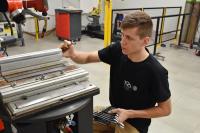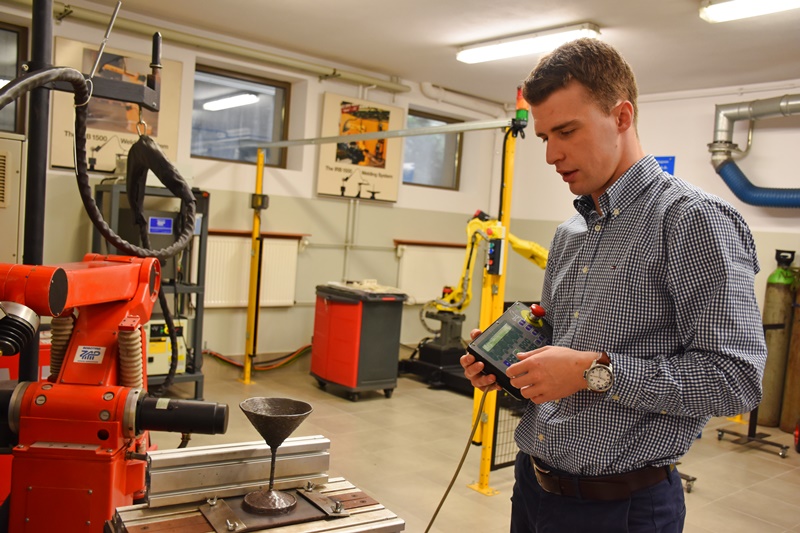JOINT Welding Science Club or How to Make a 3D Printer Out of a Welder
Nowadays, 3D printing hardly surprises anyone and the Warsaw University of Technology uses it quite often. However, the JOINT Welding Science Club offers an interesting solution—printing metal parts in a way that is completely different from previously used methods. Their welder became a printer. How?
It’s not impossible at all. Students from the JOINT Welding Science Club operating at the Faculty of Production Engineering of the Warsaw University of Technology, supervised by Paweł Cegielski Ph.D., D.Sc., decided to print metal parts using arc weld-surfacing. It consists in depositing melted wire extruded from the welder electrode clamp onto metal surfaces. Surfacing is most commonly used to regenerate used machinery parts. No one has previously used a welder to print entire objects.
‘In the 90s, they tried to build similar devices, but they were very massive, thick-walled, often weighing a dozen or so kg,’ explains Mateusz Ostrysz, president of the JOINT Welding Science Club. ‘Nowadays, machines enable us to make thin-walled components. We have performed thousands of trials, tested various parameters, and finally obtained satisfying results.’
How Does It Work?
The electrode is a metal wire that is extruded from the torch. Because the electric arc between the electrode and material is burning, a pool of liquid metal is created and very quickly solidifies.
Each subsequent layer partially melts the previous one. Next, metal layers are placed on top of each other until the target structure is created. At the same time, subsequent layers partially melt previous layers, which is key for guaranteeing high functional properties and homogeneous structure. ‘We’ve checked them under a microscope,’ says Mateusz Ostrysz. ‘The structure is fine-grained, i.e. characteristic for steel from a foundry. The metal looks like it wasn’t ever subjected to welding processes. Thanks to this, the material is of good quality, which we have proven during strength tests.’
It doesn’t matter what shape needs to be printed. The machine only needs to be correctly programmed and it will basically do its job all on its own.
Surfacing vs. Other Methods
All known methods of producing metal components are imperfect. Metal components are most often made using conventional casting or removal methods. The material removal process creates a lot of waste, while casting expends a lot of energy. Moreover, casting costs depend on the number of ordered components. Currently, metal components are also made by sintering or melting metal powders. It is possible only by using laser printers. ‘We wanted to challenge the laser methods of printing metal components,’ explains Mateusz Ostrysz. ‘There are 3D printing techniques that offer extremely good mechanical and functional properties, and the effects look great, but the cost is very high.’
A laser 3D printer costs several million euros, while the entire device that prints by surfacing used by the students from the Science Club costs several hundred thousand zloty. Furthermore, a laser uses up energy at a level of a dozen or so kilowatts, whereas a welder uses several hundred watts. It’s less than a refrigerator. Naturally, laser printers are exceptional at making very complex, small and precise structures, but not everything requires such a complex technology. Price of materials for laser printers also increases the cost of manufacture—powders used in laser techniques are several times more expensive than wire.
Electron beam sintering is an interesting method of metal printing. A large issue here is that the process takes place in a vacuum chamber—and creating a vacuum is very time-consuming. Nevertheless, vacuum allows us to melt metal dusts that easily react with oxygen and require a special chamber. Removing oxygen from the process prevents negative changes in metal properties due to its oxidization or other detrimental processes.
It’s only a beginning
So far, students from the JOINT Welding Science Club have been printing using low-alloy and stainless steel, which is most commonly used in the industry. In the future, they want to use magnesium, nickel, titanium, or aluminium. Their idea of printing metal by surfacing was recognized at this year’s KOKON competition—which is aimed at students of engineering who are active in science clubs. The project titled 3D Printing by Robotized Surfacing won in the category Innovation and New Technologies.
Monika Bukowska
Office for Promotion and Information










